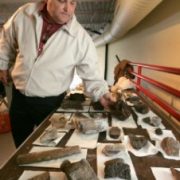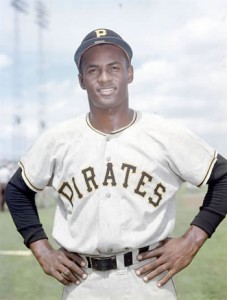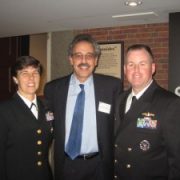Mastodon Menagerie
Special thanks for this guest post to James “Zach” Zacharias, Senior Curator of Education and Curator of History at The Museum of Arts and Sciences, a Smithsonian Affiliate in Daytona Beach, Florida.
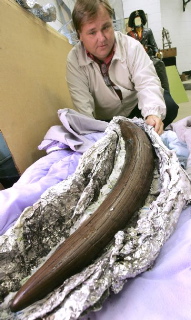
James "Zach" Zacharias, Senior Curator of Education at the Museum of Arts and Sciences, with one of the tusks from an adult mastodon. Photo courtesy of The Museum of Arts and Sciences.
The Monday morning before Thanksgiving 2011 seemed like any other day at the Museum of Arts & Sciences (MOAS) until the City of Daytona Beach emailed me a picture of what appeared to be a large lower jawbone. The City had been excavating a drainage pond two miles north of the Museum and workers found massive and mysterious bones. Upon closer inspection of the image, it became clear to me that I was looking at the lower mandible and teeth of an American Mastodon.
The City promptly postponed construction so MOAS could dispatch personnel to the site. Although I was in a shirt and tie, I jumped into the mud- and muck-filled pit for a closer look! Within five minutes, I located a partially exposed tusk protruding from the pond’s north wall. As I investigated the layers of earth, I knew right there and then this was the tusk of an Ice Age mammoth or mastodon. It dawned on me this was turning into an incredible prehistoric discovery for our area. With hopes of unearthing the full skeleton, we set to work.
An army of Museum staff and associates quickly converged on the site to help in the excavation effort. With painstaking care and effort, two delicate partial tusks were removed. These precious pieces of the Pleistocene were each placed in a “plaster jacket” (a protective covering used by paleontologists to move fossil specimens from the field) and moved to their secure home at the Museum.

Assorted museum staff and volunteers at the construction site at the bottom of the drainage pond being excavated. Photo courtesy of The Museum of Arts and Sciences.
The rest of the excavation soon turned into a salvage operation. Unbeknownst to the workers, a portion of the skeleton (other than tusks) which was interspersed amongst the rocks and stones had been routinely put through a giant rock screener. This broke up some parts of the skeletal remains. As MOAS representatives sifted through the debris piles, a plethora of broken vertebra, ribs, limbs and skull bones were found. Currently, MOAS is cleaning, sorting and accessioning the fossils. A portion of the femur is currently being prepared for carbon dating by the Smithsonian National Museum of Natural History.

A construction worker found this lower mandible of the American Mastodon. Photo courtesy of The Museum of Arts and Sciences.
This is the second significant paleontological find for the Museum of Arts & Sciences – the first being the 1975 discovery of the remains of 13 giant ground sloths in a barrow pit near Nova and Reed Canal roads. MOAS proudly displays the most complete and best preserved giant ground sloth skeleton in the world.
Florida’s peninsula has submerged and re-emerged numerous times as the earth has passed through ice ages and warming trends. The paleontology of Florida demonstrates there were no dinosaurs here (the state was underwater during the Mesozoic Era) and this is reflected in the abundant marine fossils found in Central Florida. The animal fossils found here belong to “mega-fauna” mammals such as the giant ground sloth, mastodons and mammoths, saber cats, dire wolfs, paleo llamas, and the glyptodon. They roamed our landscape from 130,000 to 10,000 years ago.
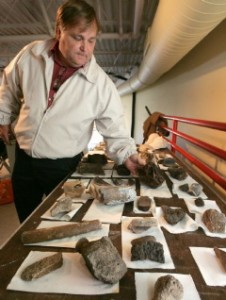
James "Zach" Zacharias with the assorted bone fragments from the mastodon. Photo courtesy of The Museum of Arts and Sciences.
The discovery of the Daytona Beach American Mastodon is thrilling and exciting for the Museum, the City and our community. MOAS is looking forward to adding the fossils to an exhibit for all to see –encouraging inspiration, curiosity, and the love of knowledge.

